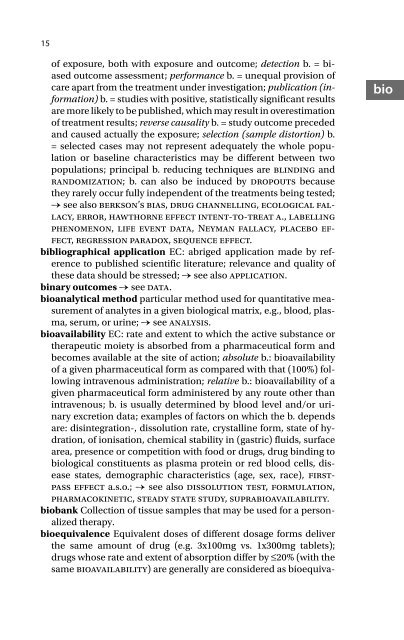220-Dictionary of Pharmaceutical Medicine, 2nd Edition-Gerhard Nahler Annette Mollet-3211898352-S
220-Dictionary of Pharmaceutical Medicine, 2nd Edition-Gerhard Nahler Annette Mollet-3211898352-S
220-Dictionary of Pharmaceutical Medicine, 2nd Edition-Gerhard Nahler Annette Mollet-3211898352-S
You also want an ePaper? Increase the reach of your titles
YUMPU automatically turns print PDFs into web optimized ePapers that Google loves.
15<strong>of</strong> exposure, both with exposure and outcome; detection b. = biasedoutcome assessment; performance b. = unequal provision <strong>of</strong>care apart from the treatment under investigation; publication (information)b. = studies with positive, statistically significant resultsare more likely to be published, which may result in overestimation<strong>of</strong> treatment results; reverse causality b. = study outcome precededand caused actually the exposure; selection (sample distortion) b.= selected cases may not represent adequately the whole populationor baseline characteristics may be different between twopopulations; principal b. reducing techniques are blinding andrandomization; b. can also be induced by dropouts becausethey rarely occur fully independent <strong>of</strong> the treatments being tested;→ see also berkson’s bias, drug channelling, ecological fallacy,error, hawthorne effect intent-to-treat a., labellingphenomenon, life event data, Neyman fallacy, placebo effect,regression paradox, sequence effect.bibliographical application EC: abriged application made by referenceto published scientific literature; relevance and quality <strong>of</strong>these data should be stressed; → see also application.binary outcomes → see data.bioanalytical method particular method used for quantitative measurement<strong>of</strong> analytes in a given biological matrix, e.g., blood, plasma,serum, or urine; → see analysis.bioavailability EC: rate and extent to which the active substance ortherapeutic moiety is absorbed from a pharmaceutical form andbecomes available at the site <strong>of</strong> action; absolute b.: bioavailability<strong>of</strong> a given pharmaceutical form as compared with that (100%) followingintravenous administration; relative b.: bioavailability <strong>of</strong> agiven pharmaceutical form administered by any route other thanintravenous; b. is usually determined by blood level and/or urinaryexcretion data; examples <strong>of</strong> factors on which the b. dependsare: disintegration-, dissolution rate, crystalline form, state <strong>of</strong> hydration,<strong>of</strong> ionisation, chemical stability in (gastric) fluids, surfacearea, presence or competition with food or drugs, drug binding tobiological constituents as plasma protein or red blood cells, diseasestates, demographic characteristics (age, sex, race), firstpasseffect a.s.o.; → see also dissolution test, formulation,pharmacokinetic, steady state study, suprabioavailability.biobank Collection <strong>of</strong> tissue samples that may be used for a personalizedtherapy.bioequivalence Equivalent doses <strong>of</strong> different dosage forms deliverthe same amount <strong>of</strong> drug (e.g. 3x100mg vs. 1x300mg tablets);drugs whose rate and extent <strong>of</strong> absorption differ by ≤20% (with thesame bioavailability) are generally are considered as bioequiva-bio


